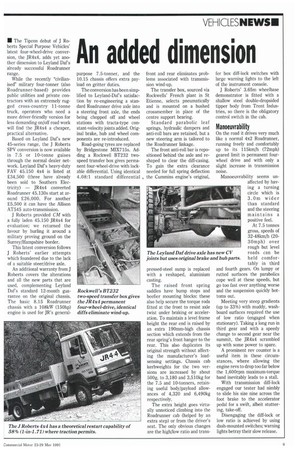An added dimension
Page 11

If you've noticed an error in this article please click here to report it so we can fix it.
• The Tipcon debut of J Roberts Special Purpose Vehicles' latest four-wheel-drive conversion, the JR4x4, adds yet another dimension to Leyland Daf's already successful Roadrunner range.
While the recently "civilianised" military four-tonner (also Roadrunner-based) provides public utilities and private contractors with an extremely rugged cross-country 11-tonne truck, operators who need a more driver-friendly version for less demanding on/off road work will find the JR4x4 a cheaper, practical alternative.
Based on Leyland Daf's new 45-series range, the J Roberts SPV conversion is now available in 7.5 or 10-tonne guises through the normal dealer network. Leyland Daf's heavy-duty FAY 45.150 4x4 is listed at £34,500 (three have already been sold to Southern Electricity) — JR4x4 converted Roadrunner 45.130s start at around £26,000. For another £5,500 it can have the Allison AT545 auto-transmission.
J Roberts provided CM with a fully laden 45.150 JR4x4 for evaluation; we returned the favour by hurling it around a military proving ground on the Surrey/Hampshire border.
This latest conversion follows J Roberts' earlier attempts which foundered due to the lack of a suitable steer/drive axle.
An additional warranty from J Roberts covers the alterations and all the new parts that are used, complementing Leyland Daf's standard 12-month guarantee on the original chassis. The basic 8.15 Roadrunner chassis with a 108kW (150hp) engine is used for JR's general purpose 7.5-tonner, and the 10.15 chassis offers extra payload on gritter duties.
The conversion has been simplified to Leyland-Daf's satisfaction by re-engineering a standard Roadrunner drive axle into a steering front axle, the ends being chopped off and wheel stations with tracta-type constant-velocity joints added. Original brake, hub and wheel components are re-introduced.
Road-going tyres are replaced by Bridgestone MIX715s. Adding a Rockwell BT232 twospeed transfer box gives permanent four-wheel-drive with lockable differential. Using identical 4.08:1 standard differential front and rear eliminates problems associated with transmission wind-up.
The transfer box, sourced via Rockwells' French plant in St Etienne, selects pneumatically and is mounted on a bushed crossmember in place of the centre support bearing.
Standard parabolic leaf springs, hydraulic dampers and anti-roll bars are retained, but a new steering arm is tailored to the Roadrunner linkage.
The front anti-roll bar is repositioned behind the axle and reshaped to clear the dill-casing. To gain the extra clearance needed for full spring deflection c, the Cummins engine's original,
pressed-steel sump is replaced with a reshaped, aluminium casting.
The raised front spring saddles have bump stops and beefier mounting blocks: these also help secure the torque rods fitted at the front to resist axle twist under braking or acceleration. To maintain a level frame height the rear end is raised by an extra 190mm-high chassis section which extends from the rear spring's front hanger to the rear. This also duplicates its original strength without affecting the manufacturer's loadsensing settings. Chassis cab kerbweights for the two versions are increased by about 500g, to 3,180 and 3,510kg for the 7.5 and 10-tonners, retaining useful body/payload allowances of 4,320 and 6,490kg respectively.
The extra height goes virtually unnoticed climbing into the Roadrunner cab (helped by an extra step) or from the driver's seat. The only obvious changes are the high/low ratio and trans
fer box diff-lock switches with large warning lights to the left of the instrument console.
J Roberts' 3.65m wheelbase demonstrator is fitted with a shallow steel double-dropsided tipper body from Trent Industries, so there is the obligatory control switch in the cab.
Manoeuvrability
On the road it drives very much like a normal 4x2 Roadrunner, running freely and comfortably up to its 115km/h (72mph) geared limit in permanent fourwheel drive and with only a slight increase in transmission noise.
Manoeuvrability seems unaffected by having a turning circle which is 3.0m wider than standard and the steering maintains a positive feel.
At 7.5 tonnes gross, speeds of 32-48km/h (2030mph) over rough but level roads can be held comfortably in third and fourth gears. On lumpy or rutted surfaces the parabolics cope well at these speeds, but go too fast over anything worse and the suspension quickly bottoms out.
Meeting very steep gradients (up to 33%) with muddy, washboard surfaces required the use of low ratio (engaged when stationary). Taking a long run in third gear and with a speedy change to second gear near the summit, the JR4x4 scrambled up with some power to spare.
A prominent rev counter is a useful item in these circumstances, where allowing the engine revs to drop too far below the 1,600rpm maximum-torque band inevitably leads to a stall.
With transmission diff-lock engaged our tester had nimbly to slide his size nine across the foot brake to the accelerator pedal for a swift, albeit stuttering, take-off.
Disengaging the dill-lock or low ratio is achieved by using dash-mounted switches; warning lights betray their slow release.








































































































